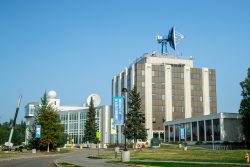As NASA readies for Mars landing, UAF research into red planet continues
February 17, 2021
Rod Boyce
907-347-9105

NASA’s Perseverance lander is expected to touch down on Mars on Thursday on a mission aimed at looking for clues about life on the red planet. As it does, additional NASA-funded Mars research continues at the Geophysical Institute at the University of Alaska Fairbanks.
Why explore Mars?
“Mars is likely the first destination outside of the Earth-moon system that humans will visit,” said Robert Herrick, a research professor at the Geophysical Institute who studies the geology and geophysics of solid bodies in the solar system. “There will almost certainly be a permanent human presence on Mars by the halfway point of this century.
“Because the warmest parts of Mars overlap in temperature with the coldest parts of Earth, from frozen dunes to lava flows over permafrost, Alaska has been a target of study for Mars analogs and instrument testing.”

Herrick is in the final year of a three-year NASA-funded project to analyze the craters on Mars and is the principal investigator on the work. This is his second three-year study of Martian craters.
Mars isn’t the only body in our solar system to have the attention of Geophysical Institute researchers. The sun, Mercury, Venus, Jupiter and Pluto have all been the subject of study at the research institute.
The Geophysical Institute is a key partner in NASA’s overall mission of driving advances in science, technology, aeronautics and space exploration to benefit Earth.

“NASA funding makes up a significant portion of our overall research budget,” Geophysical Institute Director Bob McCoy said. “We get funding from three divisions: Earth Science, which supports our Alaska Satellite Facility; Heliophysics, where a lot of our space group gets support in aurora and ionosphere research; and Planetary, where we have several researchers studying planets in the solar system.”
Aside from the economic benefit that comes to the state with that funding, there’s the research benefit to Alaskans.
“A lot of our Earth Science data is focused on climate change. It’s happening twice as fast in the Alaska and the Arctic as in the rest of the world,” McCoy said.


